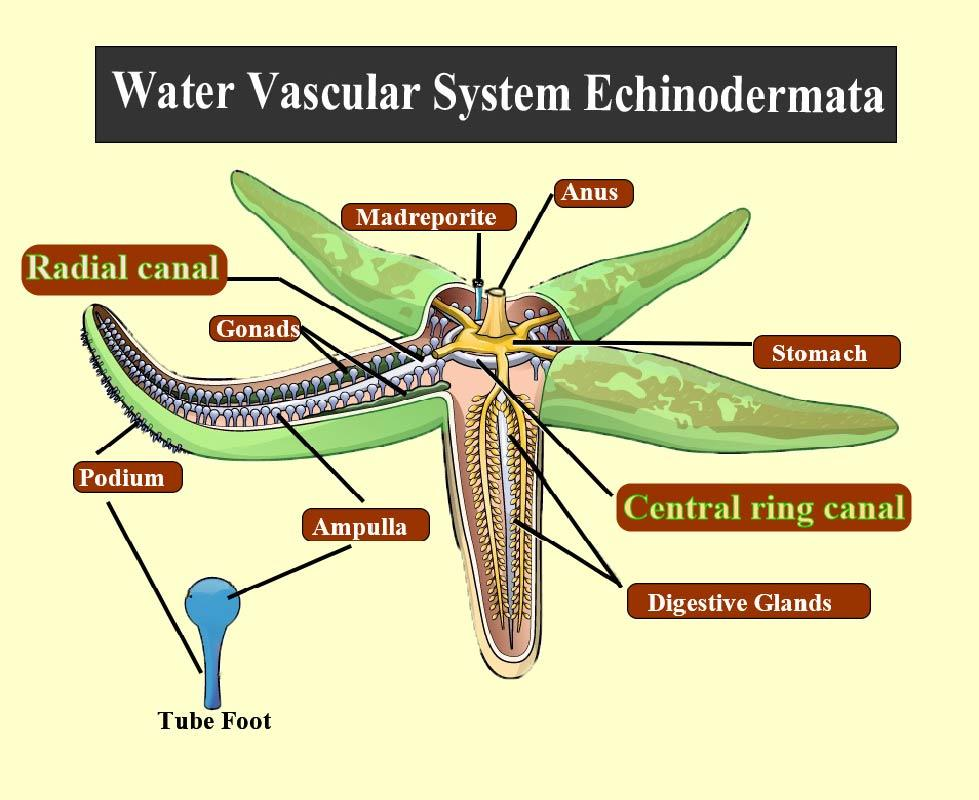
In which phylum is the water vascular system found?
A. Protozoa
B. Arthropoda
C. Porifera
D. Echinodermata
Answer
477.9k+ views
Hint: A phylum of marine invertebrates that includes starfish, sea urchins, sea cucumbers, etc. having a fluid-filled canals network that is derived from the body cavity of an individual and helps in gaseous exchange.
Complete answer:
The water vascular system is found in the phylum Echinodermata. The water vascular system is a hydraulic system that is used for locomotion, respiration, and food and waste transportation. It has canals which are connected to numerous tube feet to push the organisms against the ground.
Additional Information: -Echinoderms are the largest phylum that has no freshwater or terrestrial organisms.
-Echinoderm is a Greek word derived from echinos meaning “hedgehog “ and derma meaning “skin “.
-A unique water system is present in these organisms where a network of fluid-filled canals are derived from the coelom which helps in gaseous exchange, feeding, sensory reception, and locomotion.
-From the canals, short branches protrude out which is called a podium or tube feet.
-These tube feet are used by the organisms to settle on the surface.
-Some sea stars use these tube feet to absorb oxygen from the water column.
-The ophiuroids, a group of brittle stars and basket stars have a different vascular system than that of the sea stars, despite their similar appearance.
-The characteristic features of this phylum is that there is no fresh water or terrestrial organisms.
So, the correct answer is ‘Echinodermata'.

Note: Echinoderms possess a simple digestive system depending upon the diet of an animal. They are mostly carnivores consisting of a mouth, esophagus, two-part stomach, intestine, and rectum with anus located centrally. They also have an open circulatory system consisting of a central ring and five radial vessels, although no true heart is present.
Complete answer:
The water vascular system is found in the phylum Echinodermata. The water vascular system is a hydraulic system that is used for locomotion, respiration, and food and waste transportation. It has canals which are connected to numerous tube feet to push the organisms against the ground.
Additional Information: -Echinoderms are the largest phylum that has no freshwater or terrestrial organisms.
-Echinoderm is a Greek word derived from echinos meaning “hedgehog “ and derma meaning “skin “.
-A unique water system is present in these organisms where a network of fluid-filled canals are derived from the coelom which helps in gaseous exchange, feeding, sensory reception, and locomotion.
-From the canals, short branches protrude out which is called a podium or tube feet.
-These tube feet are used by the organisms to settle on the surface.
-Some sea stars use these tube feet to absorb oxygen from the water column.
-The ophiuroids, a group of brittle stars and basket stars have a different vascular system than that of the sea stars, despite their similar appearance.
-The characteristic features of this phylum is that there is no fresh water or terrestrial organisms.
So, the correct answer is ‘Echinodermata'.

Note: Echinoderms possess a simple digestive system depending upon the diet of an animal. They are mostly carnivores consisting of a mouth, esophagus, two-part stomach, intestine, and rectum with anus located centrally. They also have an open circulatory system consisting of a central ring and five radial vessels, although no true heart is present.
Recently Updated Pages
Glucose when reduced with HI and red Phosphorus gives class 11 chemistry CBSE

The highest possible oxidation states of Uranium and class 11 chemistry CBSE

Find the value of x if the mode of the following data class 11 maths CBSE

Which of the following can be used in the Friedel Crafts class 11 chemistry CBSE

A sphere of mass 40 kg is attracted by a second sphere class 11 physics CBSE

Statement I Reactivity of aluminium decreases when class 11 chemistry CBSE

Trending doubts
10 examples of friction in our daily life

The correct order of melting point of 14th group elements class 11 chemistry CBSE

Difference Between Prokaryotic Cells and Eukaryotic Cells

One Metric ton is equal to kg A 10000 B 1000 C 100 class 11 physics CBSE

State and prove Bernoullis theorem class 11 physics CBSE

What organs are located on the left side of your body class 11 biology CBSE




